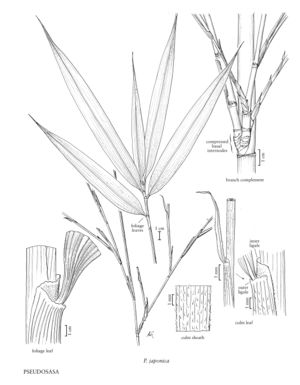Pseudosasa japonica
Culms 1-3(5) m tall, to 1.5 cm thick, erect or nodding, finely ridged; nodes slightly raised; sheath scar large; internodes long, finely mottled, with a light ring of wax below the nodes. Culm sheaths to 25 cm, basally glabrous, distally appressed-hispid, persistent; auricles and fimbriae absent; blades 2-5 cm, erect, abaxial surfaces glabrous. Branches usually 1 per node, with no basal buds or branches, sometimes rebranching from more distal nodes. Foliage leaves: sheaths glabrous, edges membranous; auricles absent or small and erect; fimbriae absent or scarce, erect; ligules long, oblique, erose, slightly pubescent, abaxial ligules glabrous to finely ciliate; blades 15-35 cm long, 1.5-5 cm wide, glabrous or abaxial surfaces sporadically shortly red-brown tomentose, light green to glaucous, adaxial surfaces dark green, glossy, glabrous. Spikelets 3.5-10 cm, narrowly cylindrical, curved, with 5-20(25) florets. Lemmas 1.2-1.5 cm, glabrous, often mucronate, mucros about 2 mm; paleas nearly equaling the lemmas, glabrous, keels finely cilate.
Distribution
Md., N.J., Va., Conn., N.Y., Calif., Del., Tenn., N.C., S.C., Pa., Fla.
Discussion
Pseudosasa japonica is a widely cultivated ornamental species that used to be grown for arrows in Japan. There are no known wild populations. It forms a tough and effective screen, and has become naturalized in British Columbia and the eastern United States. A shorter cultivar with partially ventricose culms, 'Tsutsumiana', and cultivars with variegated leaves are also available.
Selected References
None.
